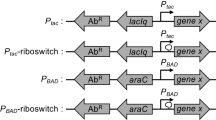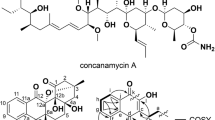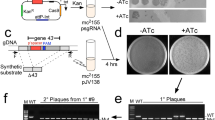Abstract
The ability of cells to discriminate between homologous and foreign genes manifests itself differently from one species to the next. Escherichia coli is well known for its ability to express genes from various donor species, including Bacillus subtilis1,2. In contrast, B. subtilis strongly discriminates against the expression of E. coli genes (there have been no corroborated reports of the expression of a wholly intact E. coli gene in B. subtilis) but expresses genes from other Gram-positive bacteria such as Staphylococcus aureus3. This apparent asymmetry in the expression of heterologous genes between E. coli and B. subtilis may reflect fundamental differences in the mechanisms of gene expression in these two model systems. Here, we have overcome the inability of B. subtilis to express E. coli chloramphenicol resistance (Cmr) by supplanting the native regulatory element(s) of this Tn9-derived gene with B. subtilis DNA fragments, which represents the first step towards dissecting the nature of this asymmetric barrier to gene expression.
This is a preview of subscription content, access via your institution
Access options
Subscribe to this journal
Receive 51 print issues and online access
$199.00 per year
only $3.90 per issue
Buy this article
- Purchase on Springer Link
- Instant access to full article PDF
Prices may be subject to local taxes which are calculated during checkout
Similar content being viewed by others
References
Kreft, J., Bernhard, K. & Goebel, W. Molec. gen. Genet. 162, 59–67 (1978).
Duncan, C. H., Wilson, G. A. & Young, F. E. Gene 1, 153–167 (1977).
Gryczan, T. J. & Dubnau, P. Proc. natn. Acad. Sci. U.S.A. 75, 1428–1432 (1978).
Gaffney, D. F., Foster, T. J. & Shaw, W. V. J. gen. Microbiol. 109, 351–358 (1978).
Shaw, W. V. & Brodsky, R. F. J. Bact. 95, 28–36 (1968).
Winshell, E. & Shaw, W. V. J. Bact. 98, 1248–1257 (1969).
Shaw, W. V. et al. Nature 282, 870–872 (1979).
Soberon, X., Covarrubias, L. & Bolivar, F. Gene 9, 287–305 (1980).
Shaw, W. V. Meth. Enzym. 43, 737–755 (1975).
Prentki, P., Karch, F., lida, S. & Meyer, J. Gene (in the press).
Uhlin, B. E. & Nordström, K. Plasmid 1, 1 (1977).
Ehrlich, S. D. Proc. natn. Acad. Sci. U.S.A. 74, 1680–1682 (1977).
Sharrock, W. J., Gold, B. M. & Rabinowitz, J. C. J. molec. Biol. 135, 627–638 (1979).
Bradford, M. Analyt. Biochem. 72, 248–254 (1976).
Alton, K. N. & Vapnek, D. Nature 282, 864–869 (1979).
Gryczan, T. J., Contente, S. & Dubnau, D. J. Bact. 134, 318–329 (1978).
Bolivar, F., Rodriguez, R., Betlach, M. & Boyer, H. W. Gene 2, 75–93 (1977).
Author information
Authors and Affiliations
Rights and permissions
About this article
Cite this article
Goldfarb, D., Doi, R. & Rodriguez, R. Expression of Tn9-derived chloramphenicol resistance in Bacillus subtilis. Nature 293, 309–311 (1981). https://doi.org/10.1038/293309a0
Received:
Accepted:
Issue Date:
DOI: https://doi.org/10.1038/293309a0
This article is cited by
-
Optimization of staphylokinase production inBacillus subtilis using inducible and constitutive promoters
Biotechnology and Bioprocess Engineering (2001)
-
Transcription termination of the streptokinase gene of Streptococcus equisimilis H46A: bidirectionality and efficiency in homologous and heterologous hosts
Molecular and General Genetics MGG (1995)
-
Mutations inbglY, the structural gene for the DNA-binding protein H1 ofEscherichia coli, increase the expression of the kanamycin resistance gene carried by plasmid pGR71
Molecular and General Genetics MGG (1992)
-
High level extracellular secretion of thermostable ?-amylase ofBacillus stearothermophilus inEscherichia coli
Biotechnology Letters (1989)
-
Hyper expression ofBacillus stearothermophilus ?-amylase gene inBacillus subtilis
Biotechnology Letters (1989)
Comments
By submitting a comment you agree to abide by our Terms and Community Guidelines. If you find something abusive or that does not comply with our terms or guidelines please flag it as inappropriate.



